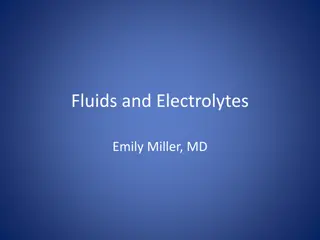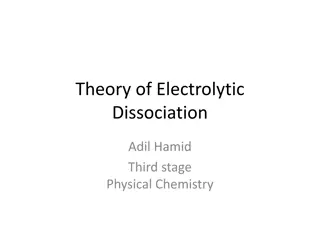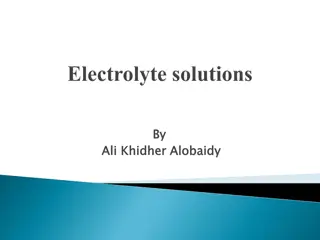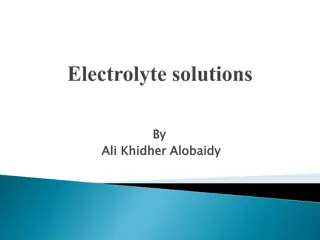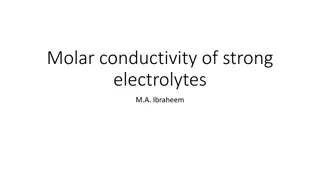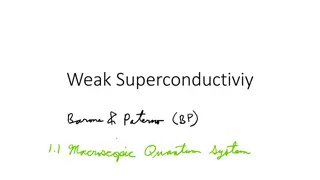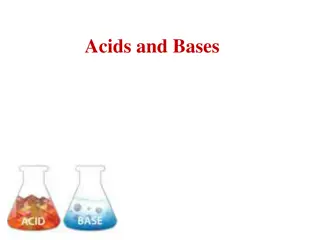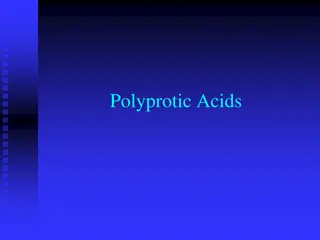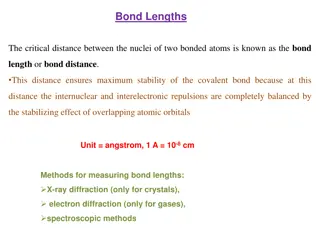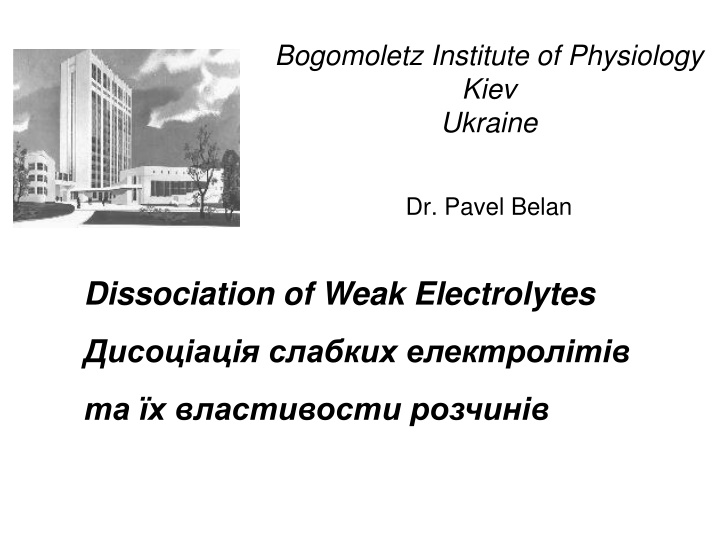
Weak Electrolyte Dissociation and pH Calculations
Explore the dissociation of weak electrolytes, Henderson-Hasselbalch equation, and buffering capacity in solutions through examples involving acetic acid. Learn how to calculate pH, concentration adjustments, and buffer solutions for various scenarios using chemical equations and simplifications.
Download Presentation

Please find below an Image/Link to download the presentation.
The content on the website is provided AS IS for your information and personal use only. It may not be sold, licensed, or shared on other websites without obtaining consent from the author. If you encounter any issues during the download, it is possible that the publisher has removed the file from their server.
You are allowed to download the files provided on this website for personal or commercial use, subject to the condition that they are used lawfully. All files are the property of their respective owners.
The content on the website is provided AS IS for your information and personal use only. It may not be sold, licensed, or shared on other websites without obtaining consent from the author.
E N D
Presentation Transcript
Bogomoletz Institute of Physiology Kiev Ukraine Dreams Dr. Pavel Belan Dissociation of Weak Electrolytes
1. . 2. Henderson Hasselbalch Equation. 3. Buffering capacity ( ) 4. 5. 6.
, : A + B VAB= k1*[A]*[B], k1 . V = k-1*[ ], k-1 . : VAB= V k1*[A]*[B] = k-1*[ ] Kd=(k-1/ k1)= [A]*[B]/[ ] Kd
Dissociation of Weak Electrolytes acid base conjugate acid conjugate base O O O H3O+ + + H2O H3C C OH H3C C Weak electrolytes are substances having only a slight tendency to form ions in solution. This makes determining the pH of solutions of weak acids a little more difficult than in the case of strong acids. The equation will be in the form of a quadratic, which must be solved. The equation frequently can be simplified by noting that the amount of dissociated species is much less than the amount of undissociated acid. [H+] [CH3COO ] [CH3COOH] = 1.74 x 10-5 M Ka = What is the final pH of a solution when 0.1 mol of acetic acid is adjusted to 1 L of water? [H+] [A ] [HA] x x 0.1 M -x [x] [x] = 1.74 x 10-5 M Ka = [0.1 M - x] x2= 1.74 x 10-6 1.74x10-5 x solve quadratic equation x2 + 1.74x10-5x 1.74x10-6 = 0 Equation can be simplified by noting that 0.1 M x is really just 0.1 M, because x is small compared to 0.1. X = 1.31*10-3M
Control task [x]2 0.1 x Ka pH = -lg(1.32 x 10-3) = 2.88
Control task What is pH of 9% (W/W or W/V or V/V) acetic acid (CH COOH)? Kafor acetic acid is 1.74*10-5M. MW60 g/mol Density: 1,05 g/
Buffering capacity of acetic acid At the same time pH of 0.1N NaOH is 13.0 Thus, acetic acid buffered 0.1N NaOH and changes its pH at 13.0-4.46=8.54; i.e [H+] concentration is higher in the final solution by ~300000000 times compared to solution containing 0.1N NaOH. How many mL of 0.1N NaOH should be added to 150 mL of 0.2 M acetic acid to have final pH=pKa of acetic acid?
Please calculate the concentration of NaOH, which should be added to 0.01 M HEPES (pKa7.5) solution to obtain pH 7.5. HEPES is a monobasic acid: HEPES = HEPES-+ H+
Dissociation Constants of Some Weak Acids Acid Ka(M) 1.78 x 10-4 1.74 x 10-5 5.62 x 10-10 1.02 x 10-7 9.12 x 10-7 4.47 x 10-3 1.66 x 10-10 1.70 x 10-4 5.75 x 10-11 7.08 x 10-3 6.31 x 10-8 3.98 x 10-13 pKa 3.75 4.76 9.25 6.99 6.04 2.35 9.78 6.37 10.20 2.14 7.20 12.40 Formic acid Acetic acid Ammoinium ion Imidazole Histidine (side chain) Glycine (carboxylate) Glycine (amino) Carbonic acid 1 Carbonic acid 2 Phosphoic acid 1 Phosphoric acid 2 Phosphoric acid 3
Weak Acids mainly used in our Experiments HEPES TRIS Properties Chemical formula Molar mass Appearance Density 1.328g/cm3 Melting point Boiling point Solubility in water ~50 g/100 mL (25 C) Acidity (pKa) 8.07 Properties Chemical formula C8H18N2O4S Molar mass Appearance Density Not applicable Melting point Solubility in water 40 g/100 ml (20 C) Acidity (pKa) 3 (pKa1), 7.5 (pKa2) C4H11NO3 121.136 g/mol White crystalline powder 238.3012 g/mol white crystalline powder >175-176 C 219 C >234-238 C
What is Ionic strength? The ionic strength of a solution is a measure of the concentration of ions in that solution. Ionic compounds, when dissolved in water, dissociate into ions. The total electrolyte concentration in solution will affect important properties such as the dissociation or the solubility of different salts. The ionic strength of the solution is the most important parameter in determining such properties of the component ions as their activities and mobilities. The ionic strength, I, of a solution is a function of the concentration of all ions present in that solution. What is ionic strength of 9% W/V acetic acid (CH COOH)? Ka for acetic acid is 1.74*10-5 M. where: I= ionic strength ci= concentration of the ithspecies, mole/L zi= valence of the ithspecies Read more: http://www.lenntech.com/calculators/activity/activitycoefficient.htm#ixzz2yqs9oFke
Calculation example Please calculate the ionic strength of the following solution: 0.05 M Na2SO4, 0.02 M KCl, 0.01 M glucose 0.02 M HEPES (acid) What is pH of this solution?
Calculation example I = 1/2 [(Concentration of Na2SO4 in M # of Sodium ions (Charge of Sodium)2) + (Concentration of Na2SO4 in M # of SO4 ions (Charge of SO4)2) + (Concentration of KCl # of Potassium ions (Charge of Potassium)2) + Concentration of KCl in M # of Chloride ions (Charge of Chloride)2)] I = 1/2 [(0.050 M 2 (+1)2) + (0.050 M 1 ( 2)2) + (0.020 M 1 (+1)2) + 0.020 M 1 ( 1)2)] = 0.17 M What is I, which 0.02 M of HEPES add? HEPES is a monobasic acid: HEPES = HEPES-+ H+ Let us denote [H+] as x. Thus: Ka= x2/(0.02-x) x Ka= 10-7.5= 10-8* 100.5=1.78 * 10-4 M Ihepes= 1/2 * (1.78 * 10-4 * (-1)2+ 1.78 * 10-4(1)2 = 1.78 * 10-4 M I 0.17 M pH = -lg(1.78 * 10-4 ) = 3.75
Osmotic concentration (osmolarity) is the osmotic coefficient, which accounts for the degree of non-ideality of the solution; n is the number of particles (e.g. ions) into which a molecule dissociates. For example: glucose has n of 1, while NaCl has n of 2; C is the molar concentration of the solute; the index i represents the identity of a particular solute.
Please calculate the osmolarity of the following solutions: 0.01 M Hepes (pKa7.5) pH of this solution was equilibrated with NaOH to 7.5. HEPES is a monobasic acid: HEPES = HEPES-+ H+
Osmolarity versus tonicity Osmolarity and tonicity are related, but different concepts. Thus, the terms ending in -osmotic (isosmotic, hyperosmotic, hyposmotic) are not synonymous with the terms ending in -tonic (isotonic, hypertonic, hypotonic). The terms are related in that they both compare the solute concentrations of two solutions separated by a membrane. The terms are different because osmolarity takes into account the total concentration of penetrating solutes and non-penetrating solutes, whereas tonicity takes into account the total concentration of only non-penetrating solutes.
Please calculate the osmolarity and tonicity of the following solutions (in relation to neuronal plasma membrane): 0.15 M NaCl, 0.01 M gluose, 0.002 M CaCl2and 0.01 M HEPES (pKa 7.5) pH of this solution was equilibrated with NaOH to 7.5. HEPES is a monobasic acid: HEPES = HEPES-+ H+ It does not cross the plasma membrane.
Home tasks Please calculate the osmolarity and tonicity of the following solutions (in relation to neuronal plasma membrane): 1. 150 mM NaCl, 20 mM gluose, 2 mM CaCl2, 1 mM, KCl and 0.01 M Hepes (pKa7.5) pH of this solution was equilibrated with NaOH to 7.2. HEPES is a monobasic acid: HEPES = HEPES-+ H+ What is a concentration of Na+in this solution? What is a concentration of OH-in this solution?


